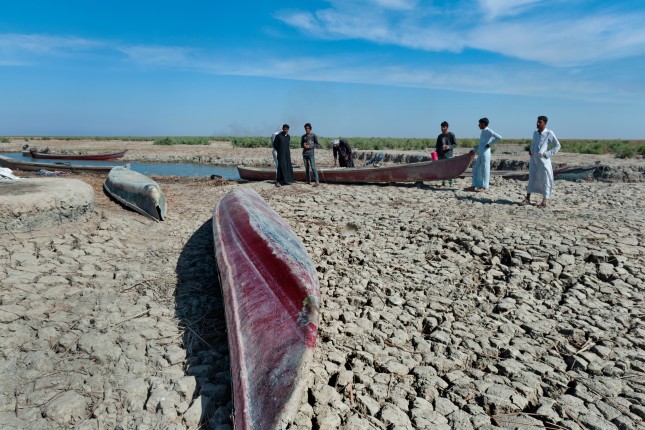-
Tackling Challenges in the MENA Region: Climate, Food Security, and Migration
May 26, 2023 By Angus Soderberg
At a recent Brookings Institution event titled Climate Change, Food Insecurity, and Migration in the Middle East, Ferid Belhaj, Vice President for the Middle East and North Africa (MENA) at the World Bank, observed that the MENA region relies heavily on grain exported from both Ukraine and Russia. When the 2022 invasion reduced grain exports to a trickle, the entire region suffered heavily.
Indeed, Russia’s invasion of Ukraine has only compounded ongoing problems that have plagued the MENA region for some time, including scarce resources, displacement, and conflict.
The Brookings event focused not only on the policy ramifications of this confluence of crises impacting the MENA region, but also on possible solutions. How can the United States and other countries—as well as international organizations—work to bolster local buy-in to address the region’s systemic problems?
Challenges in Confluence
Climate change, food insecurity, and migration converge to create conditions that have made the MENA region even more susceptible to unrest and conflict. Yet changing temperature and precipitation patterns will have long term negative effects on more than just climate. These impacts will strain governance by putting pressure on the basic services of already strained governments. Rural populations, migrants, and marginalized groups that will bear the greatest burden as a result of these forces make matters even worse, said Reva Dhingra, a post-doctoral Research Fellow at the Brookings Institute.
Among the various impacts of climate change facing the MENA region, water scarcity is the predominant issue. The region contains the top six most water-stressed countries in the world. Some estimates show that the region could lose between six and 14 percent of its GDP by 2050 as a result of water scarcity. And UNICEF estimates that close to 90 percent of children live in areas of at least high water stress, which can lead to stunted growth.
Climate change and water scarcity also contribute to the growing food insecurity throughout the MENA region. The region constituted about 20 percent of the world’s food insecure population in 2020, while only accounting for six percent of the world’s population. Aside from the war in Ukraine, rising energy prices, drought, and protracted conflict are also driving this growing food insecurity challenge.
Interlinked forces of climate change, water stress, and food insecurity also combine to exacerbate already poor economic opportunities and conflict in the region. One pronounced effect is international and internal migration.
Belhaj noted that one common path of migration runs through MENA, winding from sub-Saharan Africa through North Africa and into Europe. Yet he added that significant migration occurs within the region as well, as the Yemini population attempts to escape that nation’s conflict, and Syrians flee war into neighboring Turkey, Jordan, and Lebanon. About 4.5 million Yemenis and 6.8 million Syrians have already been displaced—and many more are in need of humanitarian assistance.
Smaller-scale migration also occurs at the sub-national level. Rural populations move into cities, a trend that stresses urban systems and can create slums. Marsin Alshamary, a non-resident Senior Fellow with the Brookings Institute, noted that in Iraq alone, “over 70,000 individuals remain displaced, mainly in southern Iraq, due to climate causes.” He added that “most of these people were employed in agriculture, livestock, or fishing”—all of which are dying industries in that country.
Immediate Needs and Long-Term Thinking
Belhaj asserted that a “two-pronged approach” is needed to tackle the intertwined climate, food insecurity, and migration crises. First, humanitarian aid and dedicated resources must be deployed to tackle immediate threats. Yet the second prong might be the most important: Long-term responses must address the root causes of the crises that they create, including the dire economic situations of origin countries that spur migration to countries with “more generous shores.”
International aid is one way to alleviate pressure. Yet Belhaj observed that there is a tension that accompanies it. Yes, the MENA region needs more aid, he continued, but there is an imperative to ensure that “whatever aid comes, it is leveraged in a way that allows countries to escape the trend of becoming totally addicted to international aid.” Civil society and institutions like the World Bank have an important role to play in this process, monitoring the flow of aid and providing research and mechanisms to effectively distribute aid to vulnerable countries.
Even where governments have the will to tackle these complex issues, they often lack the necessary resources. Will Todman, Deputy Director and Senior Fellow in the Middle East Program at the Center for Strategic and International Studies, suggested that this opens an opportunity for civil society organizations. He pointed out that entrepreneurs “can find solutions that are sensitive to the local context, the economic constraints, and the political constraints. And often the obstacles to transitioning to environmental sustainability are political because inevitably there are those who are going to lose from these transitions.”
Generating local buy-in will be a critical part of turning international aid into self-directed development. But the panelists agreed that no silver bullet exists to find effective solutions to the converging crises in the MENA region. Progress will involve linking long-term thinking and broader investments with the efforts of local actors who can sustain development beyond aid interventions.
Author: Angus Soderberg is a Staff Intern with the Environmental Change and Security Program at the Wilson Center.
Sources: The Brookings Institute, UNICEF, World Bank, UN Refugees.
Photo Credit: Boats on dried cracked earth during a drought in the Southern Marshes of Iraq, courtesy of John Wreford/Shutterstock.com.
 A Publication of the Stimson Center.
A Publication of the Stimson Center.



